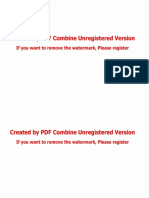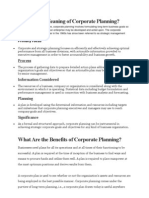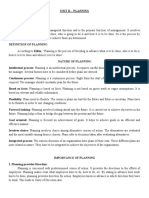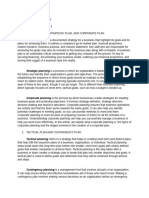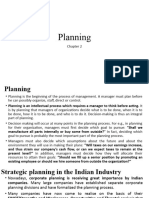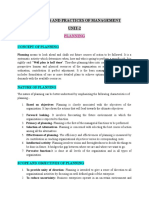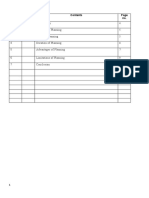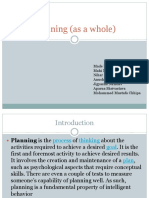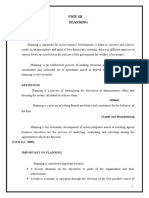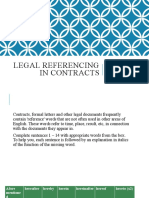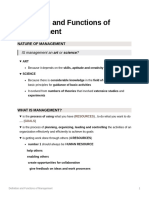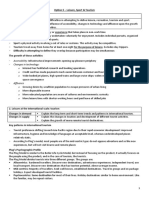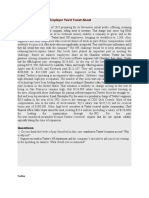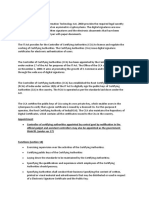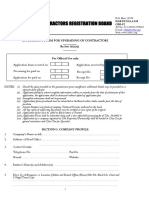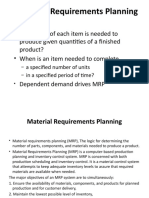MANAGERIAL ECONOMICDS
CORPORATE PLANNING AND MANAGERIAL ECONOMICS
MODULE 3
Overview
Managerial Economics is highly useful to any organization- private or public, profit-
oriented or not – that is committed to making the most efficient use of its resources in
attaining specific goals. In this module, the role of managerial economics is applied on
the process of corporate planning. Villegas, economist, author and consultant pointed
out that it is in planning where the application of economics to management is critical.
Managerial economics can be fruitful only if it becomes an integral part of corporate
strategic planning and serves as a foundation for the short and long-term business
decisions associated with the process. It is therefore, in this view that the premise is
exemplified.
Lesson 1 Corporate Planning: Introduction, Definitions
Characteristics, Scope
Lesson 2 Corporate Planning: Needs, Process and Limitations
LEARNING OUTCOMES
At the end of the module the students would be able to:
explain the significant role of managerial decision making in the corporate
organization;
recognize the similarity of the concepts on corporate development and
managerial economics;
examine the perceptions of corporate planning and its similarity to strategic
management;
justify the necessity of business planning as a primary role of managerial
executive;
analyze the opportunities of macro forecasting;
appraise the functional aspect of the company’s endeavor;
classify and recommend measures to sustain the productivity of resources
in micro aspects;
illustrate the need for corporate advancement in the third world countries;
evaluate the corporate process of forecasting and prepare measures to
modified the process;
describe the limitations of corporate expansion.
25
� MANAGERIAL ECONOMICDS
1.1 Introduction
Peter Drucker the father of modern management defines corporate planning as a
“continuous process of making entrepreneurial decisions and measuring the results
against expectations through organized systematic feedback.”
Corporate Planning is defined as the process of deciding long term goals and
objectives within the ambit of organization’s strength and weaknesses. The existing and
prospective environmental setting insuring their achievement thru integrating the short
term and long-term plans or adopting measures of structural changes in the composition
of the organization, after taking recourse to financial resources.
Elements to constitute Corporate Planning or Strategic Planning
1. Laying down long range corporate goals and objectives.
2. Macro and Micro Environments.
3. Strengths and weaknesses of the organization.
4. Integration between short term and long-term plans.
5. Structural changes in the organization.
6. Implementation of the plan.
7. Optimal use of scarce financial resources.
8. Evaluation of performance.
9. Feedback to make corporate planning more effective and purposeful.
Long term goals and objectives pertain to the areas of production, marketing, quality
and even cost of production. In the area of production, the company may specifically spell
out its goals regarding the volume of production, addition of new products or product lines.
This decision may change the structure of the organization. Similarly, the marketing
objectives may relate to market spread from domestic to international market.
To achieve the above goals and objectives, the organization shall have to assess
its strengths and weaknesses in relation to competitors and the market forces and other
components of macro and micro environments.
After assessing the strengths and weaknesses in the prevailing macro and micro
environments, the corporation shall have two options first it may resort to an expansion
programs to cope with the growing commitments to achieve the objectives laid down.
Second for the purposes of requiring and pushing forward the existing plan of action
integrating short term plans and long-term plans. The option may be the diversification or
technological upgrading. In both cases structural changes may be needed in the
composition of the organization.
The objectives of strategic planning are to achieve the desired long- term objective/
goals by making the optimal use of the scarce resources in men and material. Evaluation
of the implementation plan from the feedback may be taken for suitable measures to
achieve the desired objective and efficiency, using feedback scheme.1
1.2 Corporate Planning- Definitions
26
� MANAGERIAL ECONOMICDS
No matter if you are a new business looking to sign their first client, or an
industry leader looking to target a new audience, corporate planning is crucial to meet
your goals.
Image of human hands during discussion of business plan at meeting
1
Source: https://www.btrustlaw.com/blog/6-elements-of-successful-corporate-planning/
What Is Corporate Planning?
Corporate planning is a process that is used by businesses to map out a course of
action to grow, increase profits, gain exposure, or strengthen brand identity. 2
Villegas, B. M., a Philippines economist in the late 19ths defined corporate planning
as “formal, systematic managerial process, organized by responsibility, time an
information, insure that operational planning, project planning, strategic planning is
carried out regularly to enable top management to direct and control the future of the
enterprise.”3
Corporate planning is a sophisticated planning tool. It has been introduced into the
corporate world recently, first in USA and later in all advanced industrial countries. A
humble beginning has been made in India also. It is the determination of the long-term
goals of a company as a whole and then developing plans to achieve these goals giving
due weightage to environmental changes. It is planning for the overall organizational
performance.
Hussey a book writer, defined as “the formal process of developing objectives for
the corporation and its component parts, evolving alternative strategies to achieve and
doing this against a background of systematic appraisal of internal strengths and
weaknesses and external environmental changes, the process of translating strategy into
27
� MANAGERIAL ECONOMICDS
detailed operational plans and seeing that these plans are carried out.” This is a
comprehensive definition of corporate planning which includes deterministic, motivational
and directional elements of corporate planning.
Drucker’s view, on Corporate planning is not confined only to strategic decisions but
most specifically on the implementation of what had been planned and a periodic review
of it.
Corporate planning is quite comprehensive as it includes – (i) strategic planning,
(ii) operational planning and (iii) project planning.1
Corporate planning is creating a strategy for meeting business goals and
improving your business. A corporate plan is a roadmap that lays out your business’s
plan of action. When you focus on corporate planning, you set achievable goals and
bring your business one step closer to success. 4
Corporate planning is a type of strategic planning, responsible for mapping out a
course of strategies and their implementations to empower top-management. It optimizes
exposure, reach, leads, sales, profits, credibility, loyalty, sustainability,
and opportunities of a business.
With the help of corporate strategic planning, a business can efficiently channeled
corporate management by leveraging its resources with better penetration in the market
than the other market players.
Businesses of any size should incorporate such strategic planning, as it offers-
• Clarity & Direction
• Efficient use of resources
• A way of measuring progress
• Optimized decision-making
• Better coordination in business activities
• Effective allocation of responsibilities
• Motivation and guidance to members
• Analysis Strengths and weaknesses along with opportunities and threats
via SWOT analysis, etc.
All in all, corporate planning empowers any kind of business to accomplish its
business goals in a more effective and organized manner.5
Why Plan?
No matter the size of your business, it is crucial to have a plan. A plan is not only
beneficial to keep your business organized, but it can also help increase.
• Clarity & Direction
28
� MANAGERIAL ECONOMICDS
• Ensure efficiency use of resources
• Provide a way of measuring progress
• Support effective decision-making
• Coordinate activities
• Allocate responsibilities
• Motivate and guide staff
1.3 Corporate Planning top 6 characteristics
1. Corporate planning is a formal and systematic process.
2. It is a rational process. It requires imagination, foresight, reflective thinking,
judgement and other mental facilities.
3. Corporate planning is a continuous process. It is a dynamic exercise that
goes on throughout the company’s life.
4. Corporate planning has a long-term perspective.
5. Corporate planning provides an integrated framework within which each of
the functional and departmental plans are tied together.
6. Corporate planning is basically concerned with the future impact of present
decisions.1
Six Key Elements of a Successful Plan
As a business, you must take many factors into consideration before you begin
planning a business strategy. You must take a step outside of your position in the
business and look at the following elements as if you were a competitor or a consumer.
To create a successful corporate plan, you will need to
1. Gather Information
2. Set objectives of the plan
3. Devise strategies to meet goals
4. Implement your plan
5. Monitor plan performance
6. Evaluate the effectiveness/success of your plan
Gathering Information
The first and most important step in creating a successful corporate plan is to
gather information. Take the good, the bad, the ugly and the pretty that regard to your
specific goals. Not only should you gather this information about your own company,
but also your biggest competitors. No matter if you are a small business or large, it is
important to look at the strengths and weaknesses of the leading companies in your
industry. This can help shape your plan to avoid the costly mistakes of others.
29
� MANAGERIAL ECONOMICDS
Creating Successful Objectives & Strategies
Goals and strategies are often confused, but they couldn’t be more different. An
objective is a broad primary outcome that can be measured. A strategy is the approach
you take to reach that goal.
Some sample objectives that you can use to better shape your business’s plan are:
• Increase Sales by 20%
• Increase followers on social media by 200
• Respond to customers within 3 hours of inquiries
You can accompany these objectives with strategies will help your company “get there”.
For example:
• Objective: Make Product X a category leader in sales revenue by year, 2020.
• Strategy: Persuade buyers that Product X is the best on the market by
associating with large well-established Product X related manufacturers.
Establishing quantifiable objectives and strategies will set your business up for
success. The objective of your plan should answer, “Where are we going?” while the
strategy should answer, “How are we going to get there?”.
By setting out a plan for your business, you will be able to be confident in every
action you make. There will be a road map laid out in front of you that you can feel
confident following, because you have one the research and calculated the numbers. If
you are struggling to detail the legal implications of your plan, an estate planning
attorney will be able to better assist you. Failing to plan can quickly result in planning to
fail.3
1.4 Corporate Planning –Scope
A corporation can be effective only if it can handle successfully with the external
environment (society) in which it functions. Similarly, the corporation can function
smoothly and efficiently only if it can deploy its material, manpower and methods in a way
that it functions with optimal efficiency.
Hence to be effective and efficient the corporation has to cope with external as well
as internal environment. Corporate planning has two aspects, macro and micro; the
former is concerned with the interaction of the external environment and the latter interact
with the internal environment. The scope of corporate planning in its macro (aggregate)
and micro (functional) aspects are as follows:
Scope of Corporate Planning:
1.Aggregative (Macro) Aspects:
30
� MANAGERIAL ECONOMICDS
• Economic- National Economic Projections — Technological Progress.
• Political- Policy towards private investment.
• Social- Social mores and attitudes towards pricing and income distribution.
• Regulatory- Government controls on imports and investment, repatriations and
size of firms.
• Competition- Relative growth rate of firms, future tax trends, government policy
towards large-scale enterprise.
• The need for and extent of corporate planning within any economy is governed
basically by the factors.
1.1 Scope of Macro-Aspect of Corporate Planning:
Economic- National Planning
o G.N.P. growth forecasts.
o Inter sectoral plans.
o Role of public and private sectors.
o Monetary and fiscal policy.
o Export prospects and balance of payments trends.
o Credit policy.
o Changes in price level.
1.2 Demand
o Price policy.
o Population growth rate.
o Income-saving pattern.
o Rate of urbanization.
1.3Technological Planning
o State of indigenous technology
o Foreign collaboration and import of technology
o Facilities for research and development work.
1.4 Availability of Resources
o Materials
o Manpower
o Methods.
1.5 Infrastructure Facilities
o Transport
o Power
o Equivalent
o Land
o Finance.
31
� MANAGERIAL ECONOMICDS
1.6 Political
o Manifestoes of party in power and in opposition
o Attitudes towards nationalization and the growth of public sector
o Attitudes towards investors
o Attitudes towards workers
o Interests of different pressure groups and lobbying
o Donations to political parties.
1.7 Social
o Policies towards income distribution
o Policies towards “Social pricing”
o Attitudes towards consumption and savings
o Attitude towards social responsibility of business
o Attitude towards environmental pollution.
1.8 Regulatory
o Government Regulations-
o Industrial licensing
o Foreign exchange
o Capital and bonus issues
o Competition policy
o Repatriation of capital/dividends
o Tariff Commission.
1.9 Competitive
o Relative, growth rate of firms
o Government policy towards large business houses
o Tax policies
o Competition for market and market structure
o Competition for control of scarce resources like materials, managerial
manpower and finance
o Competition from public and cooperative sectors
The data on variety of topics and aspects has to be collected in coping with the
need for external environment. This process of scanning the external environment
indicates “monitoring of the environment”.
There is substantial inter-dependency among these various aspects, namely,
economic, political, social regulatory and competitive. The inter-dependency considers
the need for scale of planning which are the positive functions of all these factors.
32
� MANAGERIAL ECONOMICDS
The intensity of impact of each one of these factors varies from country-to-country,
from industry-to-industry, from sector-to-sector, from unit-to-unit and, from time-to-time
for the same unit. Hence, there is a real need to monitor the environment regularly and
continuously.
In particular, one may note the distinctive differences in the developed and
developing economy. Stiff competition in a developed economy is observable. Whereas
in developing countries there is less customers base competition. Instead there is a stiff
competition for claims on resources, materials, managerial manpower and finance.
Develop countries have giant-sized corporation with minimal government regulation and
control while developing countries corporations are smaller but government control and
regulations are relatively large and oppressive.
2. Functional (Micro) Aspects:
• Marketing- New products, new markets, etc.
• Production- Technical problems, research.
• Materials- Quality, availability.
• Finance- Capital structure, sources, viability.
• Manpower- Managerial, labor force projections, and development.
Additionally, it is necessary that the size of the corporation the business engaged
with has set the goals since it is crucial which may affect the planning either macro or
micro.
The second aspect of corporate planning is the “micro” which is the functional aspect
in the business operation. In broad terms the functional aspects of corporate planning
embraces marketing, production and material procurements, finance, personnel and
manpower planning. 1
33
� MANAGERIAL ECONOMICDS
An Illustration on the micro-aspects of corporate planning
2
Source: https://www.yourarticlelibrary.com/business/corporate-planning/corporate-planning-features-
process-and-analysis-management/69738
Lesson 2 Corporate Planning: Needs, Process and Limitations
2.1 Strategic Planning: Why Do We Need To Do It? / Corporate Planning - Need
Regardless of whether your business is a small start-up or one of the biggest
players in the market, you will likely have heard stories of how other organizations have
achieved success through well thought-out strategic planning.
Is strategic planning still relevant for businesses today, however, or is it just an
outdated management fad? How exactly does it help an organization?
Effective strategic management can bring many benefits to any business – here
are just four examples.
34
� MANAGERIAL ECONOMICDS
It outlines a clear path for your company
No business can hope to succeed by not having a plan and simply hoping to stumble
across success.
A strategic plan works like a roadmap, clearly defining the best route for your organization
to take in the years ahead. Whether it covers one, three or five years into the future, a
strategic plan can help guide your organization to meet the challenges that lie in wait.
It brings a sense of focus
Because a strategic plan establishes a direction for your business to take, it will help
sharpen its focus in order to get there.
Strategic planning can therefore help your organization develop the right goals and
targets and help everyone focus their efforts into meeting them.
It improves your business’s self-awareness
Taking the time to establish a comprehensive strategic plan means your business has a
better awareness of its strengths and weaknesses and where it stands in the market, both
individually and in relation to competitors.
It gives your employees something to work towards
Strategic planning isn’t just beneficial for those highest up in the management hierarchy
– it gives everyone in the organization a sense of purpose.
With a definitive mission and clear goals and objectives to work towards, your staff will
know their efforts count towards something and will be motivated to do their job.6
Corporate Planning – Need
Corporate planning is an indispensable component of strategic management.
Without corporate planning the long-term objectives and goals of the organization will not
be achieved. In addition, the corporate manager keeps himself up-to-date regarding the
status of technology, the state of strategic choices of the competitors and the policy
changes of the government.
At present, the rate of technological obsolescence is so fast that if the Corporate Manager
becomes a little sluggish, his competitors will oust him from the market. Corporate
Planning forces the Corporate Manager to install state-of-the-art technology so that the
company’s march towards the realization of long-term objectives and goals is not
hampered.
Corporate Manager, under the force of corporate planning is expected to maintain
a constant watch regarding the adoption of strategic choices by the competitors and their
35
� MANAGERIAL ECONOMICDS
impact on cost, profit and price. The manager accordingly shall have to bring about the
needful adjustment in the functioning and operating efficiency of his organization.
Policy changes by the Government are also an important variable of corporate
planning. The Corporate Manager has to keep himself up-to-date regarding changes in
such policies as industrial, monetary, fiscal or exim which have a direct bearing on the
operation of the organization. Equally important is the impact of these changes on the
overall functioning of the organization so that necessary changes in various functional
areas could be affected to maintain the desired level of efficiency.1
2.2. Corporate Planning Process
Corporate Strategic planning process steps
1. Determine your strategic position.
2. Prioritize your objectives.
3. Develop a strategic plan.
4. Execute and manage your plan.
5. Review and revise the plan.
Some businesses run by a team. Say a team of Lucid they said “Business should
have a strategic plan—but the number of businesses that try to operate without a defined
plan (or at least a clearly communicated one) might surprise you. Research from On
Strategy shows that 86% of executive teams spend less than one hour per month
discussing strategy, and 95% of a typical workforce doesn’t understand its organization’s
strategy. This means that the workforce must clearly understand the strategic plan set
forth by the company.7
Major steps involved in corporate planning are as follows:
1. Environmental Analysis and Diagnosis
The first steps (which is, in fact, the background step), involved in corporate
planning is environmental analysis and diagnosis
2. Determination of Objectives
All planning starts with the determination of the objectives. After environmental
analysis and diagnosis, the planners determine the objectives for the company. These
objectives must represent a unified or coordinated scheme and make a realistic, and
achievable objectives a “SMART” one
36
� MANAGERIAL ECONOMICDS
3. Strategy Formulation
Strategy formulation is the core aspect of corporate planning. It is the tool in
attaining the objectives of company. Setting the company’s objectives is easier compare
to the implementation of the company’s plan.
4. Development of Tactical Plans
Strategies are translated into action plans called tactical plans or operational plans.
Tactical plans are necessary for the implementation of strategies in the achieving the
goals of the company. For example, if the strategy of a company is to develop the skills
and talents of manpower a design of suitable training programs must be created.
Corporate planning and strategy formulation have a long-term perspective; while tactical
plans have a short-term perception. The latter is to be implemented immediately, in the
usual course of organizational life.
5. Implementation of Tactical Plans:
Plans has to be implemented and put into action.
6.) Follow-Up-Action
After the tactical plans have been put into practice a review of progress and
monitoring and feedback for the betterment of the corporate planning process. 8
The Steps in corporate planning process
3Source: https://www.yourarticlelibrary.com/business/corporate-planning/corporate-planning-features-
process-and-analysis-management/69738
2.3 Limitation of Corporate Planning
37
� MANAGERIAL ECONOMICDS
Planning is needed both in the business and non-business organizations. Some
people think that planning is based on the future anticipations and nothing can be said
with certainty about future. Therefore, it is a useless process.
In fact, these people point towards the difficulties in the way of planning. If planning
has to be successful and purposeful, the managers should be aware of these difficulties
and limitations of planning.
Six Main Limitations of Planning in Any Organizations
1. Planning Creates Rigidity
Although the quality of flexibility is inherent in planning, meaning thereby that in
case of need changes can be brought in, but it must be admitted that only small changes
are possible. Big changes are neither possible nor in the interest of the organization.
Since it is not possible to introduce desired changes according to the changed
situations, the organization loses many chances of earning profits. For this limited
flexibility in planning, both the internal as well as external factors are responsible. These
facts are called internal and external inflexibility.
They are as follows:
• Internal Inflexibility
At the time of planning the objectives of the organization, its policies, procedures,
rules, programs, etc. are determined. It is very difficult to bring in changes time and again.
It is known as internal inflexibility,
• External Inflexibility:
External inflexibility means various external factors that cause limited flexibility in
planning.
These factors are beyond the control of the planners. The chief among them are:
political climate, economic changes, technical changes, natural calamities, policies of the
competitors, etc.
For example, in political context, as a result of change, a new government brings
up a new trade policy, policy of taxation, import policy, etc. All these changes make every
sort of planning a meaningless waste. Similarly, a change in the policies of the
competitors suddenly makes all types of planning ineffective.
2. Planning Does Not Work in a Dynamic Environment
Planning is based on the anticipation of future happenings. Since future is
uncertain and dynamic, therefore, the future anticipations are not always true. Therefore,
to consider planning as the basis of success is like a leap in the dark.
Generally, a longer period of planning makes it less effective. Therefore, it can be
said that planning does not work in dynamic environment. For example, a company
38
� MANAGERIAL ECONOMICDS
anticipated that the government was thinking about allowing the export of some particular
product. With this hope the same company started manufacturing that product. But the
government did not allow the export of this product. In this way, the wrong anticipation
proved all planning wrong or incorrect. It brought loss instead of profit.
3.Planning Reduces Creativity
Under planning all the activities connected with the attainment of objectives of the
organization are pre-determined. Consequently, everybody works as they have been
directed to do and as it has been made clear in the plans. Therefore, it checks their
incisiveness. It means that they do not think about appropriate ways of discovering new
alternatives. According to Terry, “Planning strangulates the initiative of the employees
and compels them to work in an inflexible manner.”
4. Planning Involves Huge Costs
Planning is a small work but its process is really big. Planning becomes
meaningful only after traversing a long path. It takes a lot of time to cover this path.
During this entire period the managers remain busy in collecting a lot of information and
analyzing it. In this way, when so many people remain busy in the same activity, the
organization is bound to face huge costs.
5. Planning is a Time-consuming Process
Planning is a blessing in facing a definite situation but because of its long process
it cannot face sudden emergencies. Sudden emergencies can be in the form of some
unforeseen problem or some opportunity of profits and there has been no planning for all
these situations beforehand and which now requires immediate decision.
In such a situation, if the manager thinks of completing the planning process before taking
some decision, it may be possible that the situations may worsen or the chance of earning
profit may slip away. Thus, planning is time consuming and it delays action.
6. Planning Does Not Guarantee Success
Sometimes the managers think that planning solves all their problems. Such
thinking makes them neglect their real work and the adverse effect of such an attitude
has to be faced by the organization.
In this way, planning offers the managers a false sense of security and makes
them careless. Hence, we can say that mere planning does not ensure success; rather
efforts have to be made for it.9
Suggested Reading Links
39
� MANAGERIAL ECONOMICDS
Villegas B. M. Managerial Economics, Text and Case Studies. Pp. 20-21. Third
edition. Sinagtal Publisher, Inc. Greenhils P.O. box 536, Manila 1999.
Bdc* “Five essential tips for creating a strong corporate plan”
https://www.bdc.ca/en/articles-tools/business-strategy-planning/define-
strategy/corporate-plans-5-key-components
Madulid F. A. Module 2 Strategy Formulation, pp. 7-26.
Discussion Questions
1. What is the role of managerial economics in corporate organization?
2. Compare the similarities of the concepts on corporate planning and managerial
economics.
3. Describe the resemblance between corporate expansion and managerial finances.
4. Summarize the need of Strategic planning/corporate planning.
5. Clearly show the major steps and process of corporate planning.
6. Create possible adjustment on the restrictions brought about on planning in an
organization.
Learning Exercises/ Activities
1. Group case problem analysis.
2. Presentation of the case problems analysis.
END NOTES
1 Niti A. “Corporate Module”, Retrieved September 24, 2021.
https://www.economicsdiscussion.net/management/corporate-planning/corporate-planning/3247
2VillegasB. M. Managerial Economics Text and Case Studies. Third Edition. Greenhills P. O
Box 536, Manila. Sinagtala Publisher, Inc. 1999.
3Bochnewich Law Offices. May 1, 2015. “Six (6) elements of successful Corporate Planning”. Retrieved
on Sept. 26, 2021 https://www.btrustlaw.com/blog/6-elements-of-successful-corporate-planning/
4
Levinson, Chelsea. June 07, 2018.” Definition of corporate Planning”. Retrieved on Sept. 26, 2021.
https://bizfluent.com/about-5117185-definition-corporate-planning.html
5
Hitest Bhasin, March 30 2021. “Corporate Planning Definition” Retrieved on September 26, 2021.
https://www.marketing91.com/corporate-planning/
40
� MANAGERIAL ECONOMICDS
6Craig Catley. February 7, 2014. “Strategic Planning: Why Do We Need To Do It?” Retrieved on
September 26, 2021. https://www.strategyblocks.com/blog/why-we-need-to-do-strategic-planning/
7Lucid Team. “Corporate Strategic Planning Process”. Retrieved on September 27, 2021.
https://www.lucidchart.com/blog/5-steps-of-the-strategic-planning-process
8
Talathi R. https://www.yourarticlelibrary.com/business/corporate-planning/corporate-planning-features-
process-and-analysis-management/69738
9
Samiksha S. “Six Main Limitations of Planning in Any Organizations”
https://www.yourarticlelibrary.com/organization/6-main-limitations-of-planning-in-any-organizations/905
IMAGES
1. Image of human hands during discussion of business plan at meeting
https://www.btrustlaw.com/blog/6-elements-of-successful-corporate-planning/
2. An Illustration on the micro-aspects of corporate planning
https://www.yourarticlelibrary.com/business/corporate-planning/corporate-planning-features-
process-and-analysis-management/69738
3. The Steps in corporate planning process
https://www.yourarticlelibrary.com/business/corporate-planning/corporate-planning-features-
process-and-analysis-management/69738
41




